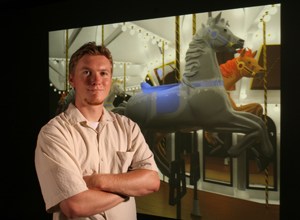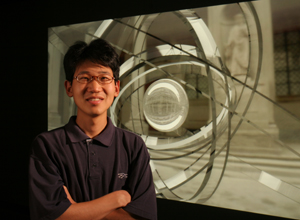UCSD Computer Graphics Students Set Their Sights on SIGGRAPH
July 13, 2005 / By Doug Ramsey
7.13.2005 -- Instead of winning statuettes or plaques, the top performers in an annual computer graphics competition at UCSD's Jacobs School of Engineering walked away with an even better prize: the chance to rub elbows with the world's best and brightest experts in computer graphics and special effects.
|
Alex Kozlowski and Will Chang won passes to attend SIGGRAPH 2005, which runs from July 31 to August 4 in Los Angeles. The annual conference attracts top computer graphics talent from academe and the entertainment industry, and typically showcases breakthroughs that later turn up in movies and videogames.
The organizer of the UCSD competition, Calit2 participant and Computer Science professor Henrik Wann Jensen, understands the power of SIGGRAPH. As a research associate at Stanford University, he worked on a new technique for improving the look of skin and other translucent objects in computer graphics. Two years after demonstrating it at SIGGRAPH, the technique, co-authored by Jensen, was being used to render the character of Gollum in the Lord of the Rings films. And one year later, Jensen was accepting an Academy Award for his work.
|
Jensen teaches CSE 168, a course on algorithms for rendering computer graphics. Graduate students Kozlowski and Chang took the course in the spring. "It was hard work but a lot of fun," smiles Chang. "This was my first opportunity to design and implement a complete renderer." Adds Kozlowski: "Most of my graphics experience has been in procedural modeling and virtual reality, so this course gave me a real opportunity to get my feet wet in realistic rendering."
Realistic rendering is the Holy Grail of computer graphics: the ability to create scenes from scratch on the computer that look as real as the real thing. For the competition, Jensen invited students to render a realistic object or scene of their own choosing.
An external panel of experts picked the winners based on the quality of their rendered images and the technical difficulty. This year's judges included Pixar's Ronen Barzel and Mark Rotenberg of Bunkspeed Studios, as well as the winner of last year's competition, Wojciech Jarosz, who TA'd the course this spring.
Alex Kozlowski won the Grand Prize for Carousel at Night , inspired by Ray Bradbury's novel "Something Wicked This Way Comes." He achieved the stunning image (pictured at left) of a carousel with brightly-painted wooden horses by implementing a number of techniques that went beyond what was taught in the course.
"I implemented a few different effects, such as glossy reflections, bump mapping, tone mapping, depth-of-field and super-sampling," says Kozlowski, who did his undergraduate work at UC Berkeley. "I also modeled the carousel from scratch, which the judges seemed to like, though it's not a part of the rendering course."
The final scene features more than 1.5 million triangles -- including roughly 150,000 for each horse. Kozlowski also created a 3-D bump map for the floor to achieve a cut wood effect. (Bump mapping relies on light-reflection calculations to create small bumps on the surface of an object in order to give it texture.) "I also used photon mapping to do all the indirect lighting in the scene," he noted. "Most of the brown color you see on the floor is due almost entirely to indirect lighting."
|
The runner-up in the rendering competition, Will Chang, produced a two-minute animated video called The Joy of Environment Maps. "I decided to render a scene containing multiple concentric rings, each rotating around a different axis," says Chang. "I originally got the idea from Paul Debevec's short film Fiat Lux and decided to match my skill against his."
Fiat Lux was a big hit when it was unveiled at SIGGRAPH 1999, winning its UC Berkeley author a reputation as a pioneer in realistic rendering. (Debevec is now at the University of Southern California.)
Environment maps involve deriving the lighting in a scene from actual photographs. "I think this technique brought an incredible amount of realism into the scene," says Chang, a graduate of Harvey Mudd College who also used distribution ray tracing, path tracing, photon mapping and stratified super-sampling to construct his First Prize entry. "I have always felt that the primary strength of ray-tracing algorithms is their ability to simulate light reflecting and refracting accurately. Combined with real-world lighting, scenes containing even the simplest of primitives become very exciting."
|
To attend SIGGRAPH, Chang and Kozlowski will break away from their current summer jobs doing research in professor Jensen's lab. Chang is working on ways to render very large scenes quickly and accurately, and Kozlowski is exploring new techniques for shading complex point sample geometry. (Point-based rendering methods represent the scene's geometry as a set of points, allowing for faster rendering of extremely complex geometry.)
Both graduate students are planning to get their Ph.D.s, but neither will rule out a detour into the entertainment industry. "I think it's a very exciting time to do research in computer graphics," enthuses Chang, who says he won't make a career decision until after grad school.
Grand Prize winner Kozlowski is also undecided. He says he wants to do academic research, but "would really also like to spend some time in the movie industry."
Special-effects companies routinely hire computer scientists as they try to create and implement new ways to build effects that look as close to real life as possible. And as Kozlowski and Chang proved with their award-winning renderings, they now have the tools to do so -- whether they decide to "go Hollywood," or make their careers on campus instead.
Related Links
Rendering Algorithms Spring 2005
SIGGRAPH 2005
Carousel at Night
The Joy of Environment Maps
Henrik Wann Jensen Website
Media Contacts Media Contact: Doug Ramsey, (858) 822-5825, dramsey@ucsd.edu





